check engine light HYUNDAI SONATA HYBRID 2021 Owner's Manual
[x] Cancel search | Manufacturer: HYUNDAI, Model Year: 2021, Model line: SONATA HYBRID, Model: HYUNDAI SONATA HYBRID 2021Pages: 527, PDF Size: 64.14 MB
Page 338 of 527
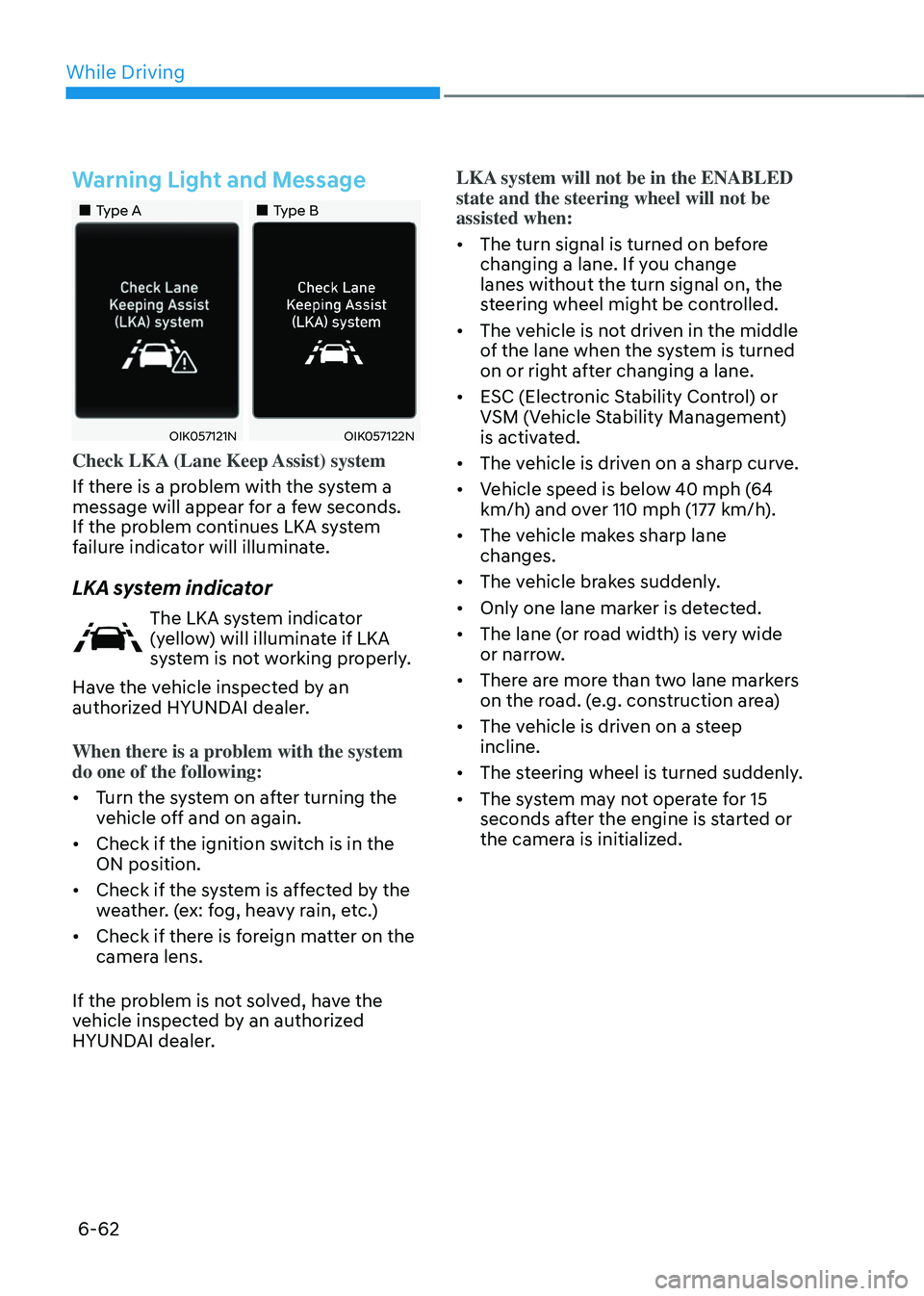
While Driving
6-62
Warning Light and Message
„„Type A„„Type B
OIK057121NOIK057122N
Check LKA (Lane Keep Assist) system
If there is a problem with the system a
message will appear for a few seconds.
If the problem continues LKA system
failure indicator will illuminate.
LKA system indicator
The LKA system indicator
(yellow) will illuminate if LKA
system is not working properly.
Have the vehicle inspected by an
authorized HYUNDAI dealer.
When there is a problem with the system
do one of the following:
• Turn the system on after turning the
vehicle off and on again.
• Check if the ignition switch is in the
ON position.
• Check if the system is affected by the
weather. (ex: fog, heavy rain, etc.)
• Check if there is foreign matter on the
camera lens.
If the problem is not solved, have the
vehicle inspected by an authorized
HYUNDAI dealer. LKA system will not be in the ENABLED
state and the steering wheel will not be
assisted when:
•
The turn signal is turned on before
changing a lane. If you change
lanes without the turn signal on, the
steering wheel might be controlled.
• The vehicle is not driven in the middle
of the lane when the system is turned
on or right after changing a lane.
• ESC (Electronic Stability Control) or
VSM (Vehicle Stability Management)
is activated.
• The vehicle is driven on a sharp curve.
• Vehicle speed is below 40 mph (64
km/h) and over 110 mph (177 km/h).
• The vehicle makes sharp lane
changes.
• The vehicle brakes suddenly.
• Only one lane marker is detected.
• The lane (or road width) is very wide
or narrow.
• There are more than two lane markers
on the road. (e.g. construction area)
• The vehicle is driven on a steep
incline.
• The steering wheel is turned suddenly.
• The system may not operate for 15
seconds after the engine is started or
the camera is initialized.
Page 411 of 527
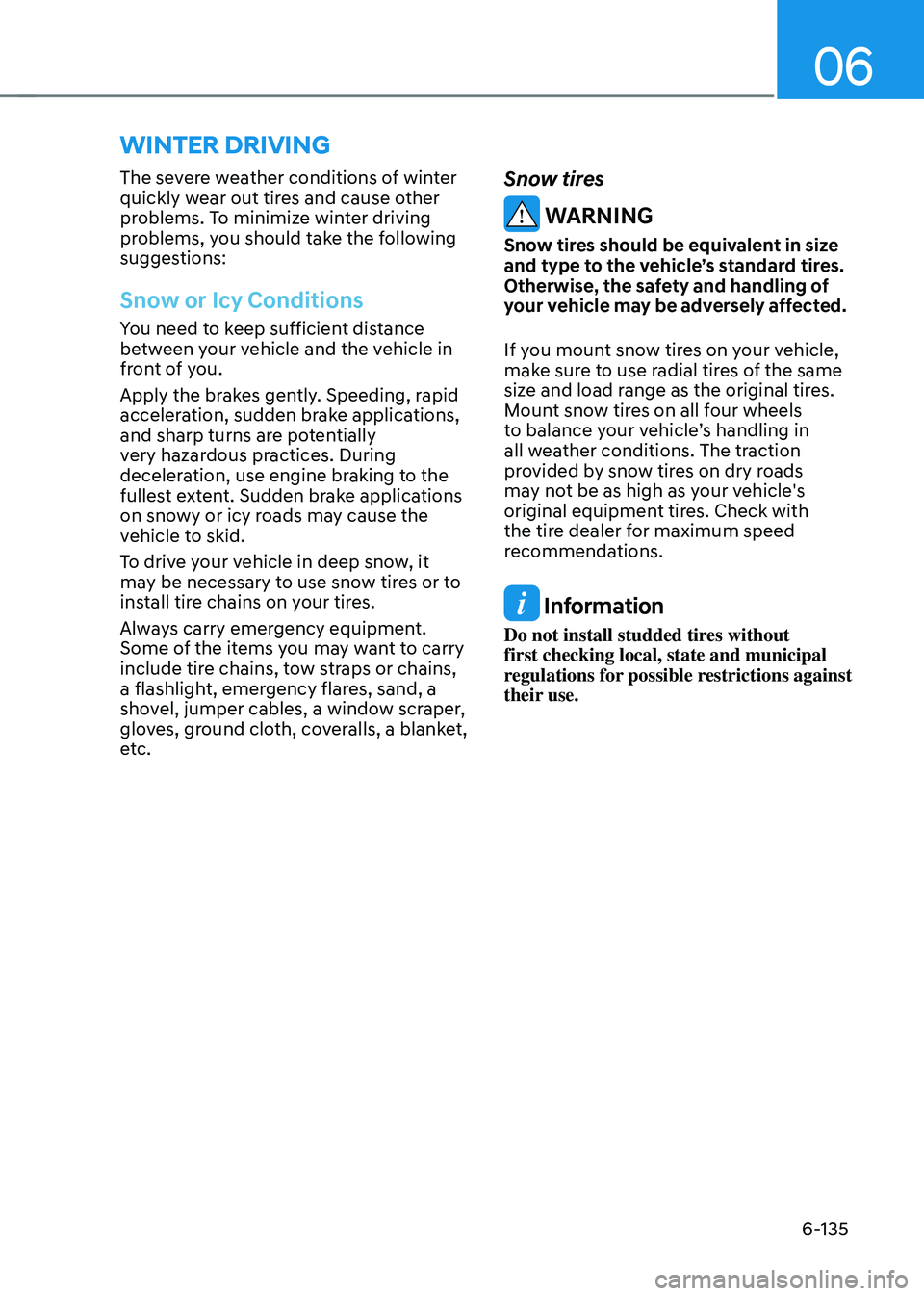
06
6-135
The severe weather conditions of winter
quickly wear out tires and cause other
problems. To minimize winter driving
problems, you should take the following
suggestions:
Snow or Icy Conditions
You need to keep sufficient distance
between your vehicle and the vehicle in
front of you.
Apply the brakes gently. Speeding, rapid
acceleration, sudden brake applications,
and sharp turns are potentially
very hazardous practices. During
deceleration, use engine braking to the
fullest extent. Sudden brake applications
on snowy or icy roads may cause the
vehicle to skid.
To drive your vehicle in deep snow, it
may be necessary to use snow tires or to
install tire chains on your tires.
Always carry emergency equipment.
Some of the items you may want to carry
include tire chains, tow straps or chains,
a flashlight, emergency flares, sand, a
shovel, jumper cables, a window scraper,
gloves, ground cloth, coveralls, a blanket,
etc.
Snow tires
WARNING
Snow tires should be equivalent in size
and type to the vehicle’s standard tires.
Otherwise, the safety and handling of
your vehicle may be adversely affected.
If you mount snow tires on your vehicle,
make sure to use radial tires of the same
size and load range as the original tires.
Mount snow tires on all four wheels
to balance your vehicle’s handling in
all weather conditions. The traction
provided by snow tires on dry roads
may not be as high as your vehicle's
original equipment tires. Check with
the tire dealer for maximum speed
recommendations.
Information
Do not install studded tires without
first checking local, state and municipal
regulations for possible restrictions against
their use.
WINTER DRIVING
Page 425 of 527
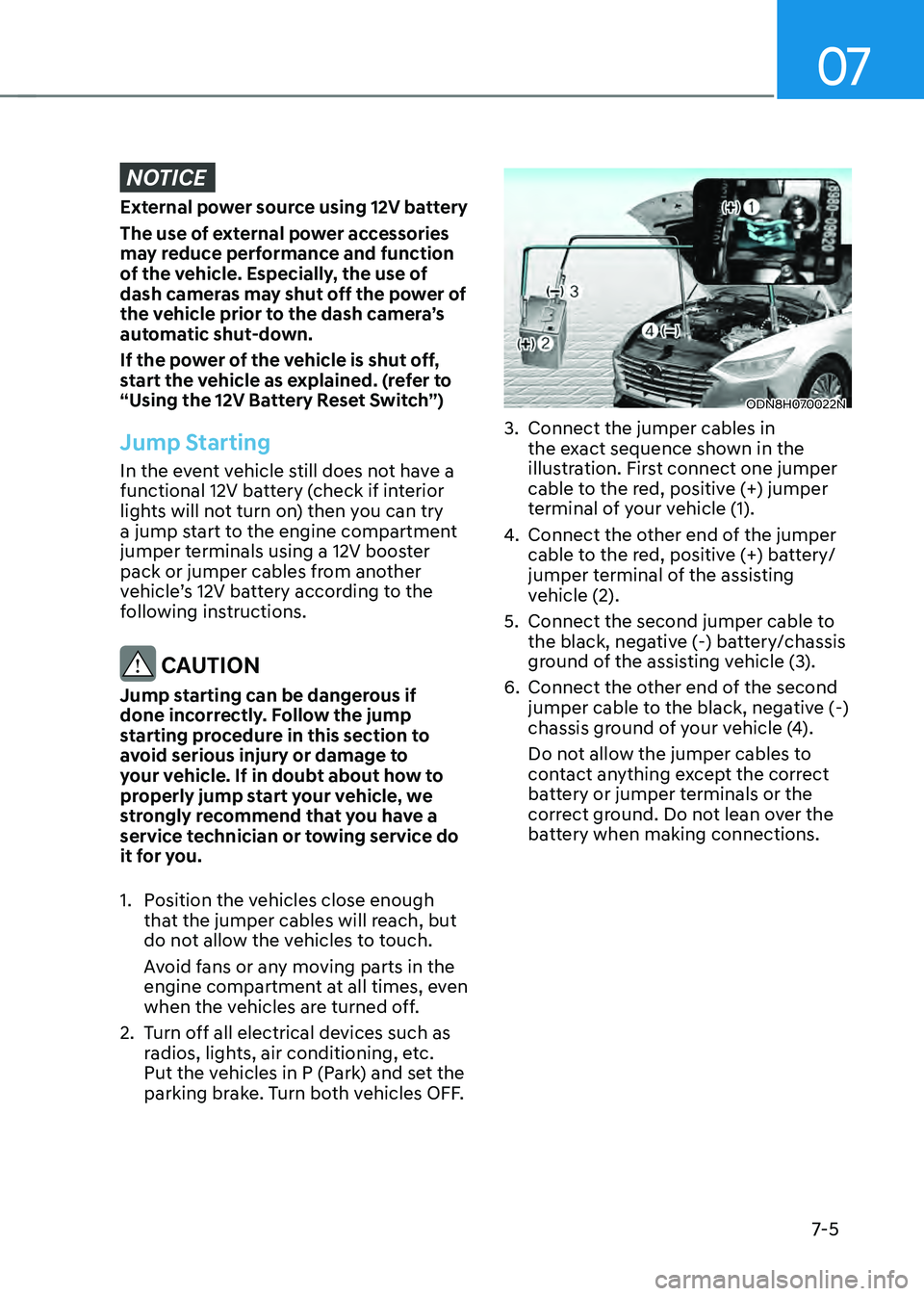
07
7-5
NOTICE
External power source using 12V battery
The use of external power accessories
may reduce performance and function
of the vehicle. Especially, the use of
dash cameras may shut off the power of
the vehicle prior to the dash camera’s
automatic shut-down.
If the power of the vehicle is shut off,
start the vehicle as explained. (refer to
“Using the 12V Battery Reset Switch”)
Jump Starting
In the event vehicle still does not have a
functional 12V battery (check if interior
lights will not turn on) then you can try
a jump start to the engine compartment
jumper terminals using a 12V booster
pack or jumper cables from another
vehicle’s 12V battery according to the
following instructions.
CAUTION
Jump starting can be dangerous if
done incorrectly. Follow the jump
starting procedure in this section to
avoid serious injury or damage to
your vehicle. If in doubt about how to
properly jump start your vehicle, we
strongly recommend that you have a
service technician or towing service do
it for you.
1. Position the vehicles close enough
that the jumper cables will reach, but
do not allow the vehicles to touch.
Avoid fans or any moving parts in the
engine compartment at all times, even
when the vehicles are turned off.
2. Turn off all electrical devices such as
radios, lights, air conditioning, etc.
Put the vehicles in P (Park) and set the
parking brake. Turn both vehicles OFF.
ODN8H070022N
3. Connect the jumper cables in
the exact sequence shown in the
illustration. First connect one jumper
cable to the red, positive (+) jumper
terminal of your vehicle (1).
4. Connect the other end of the jumper
cable to the red, positive (+) battery/
jumper terminal of the assisting
vehicle (2).
5. Connect the second jumper cable to
the black, negative (-) battery/chassis
ground of the assisting vehicle (3).
6. Connect the other end of the second
jumper cable to the black, negative (-)
chassis ground of your vehicle (4).
Do not allow the jumper cables to
contact anything except the correct
battery or jumper terminals or the
correct ground. Do not lean over the
battery when making connections.
Page 451 of 527
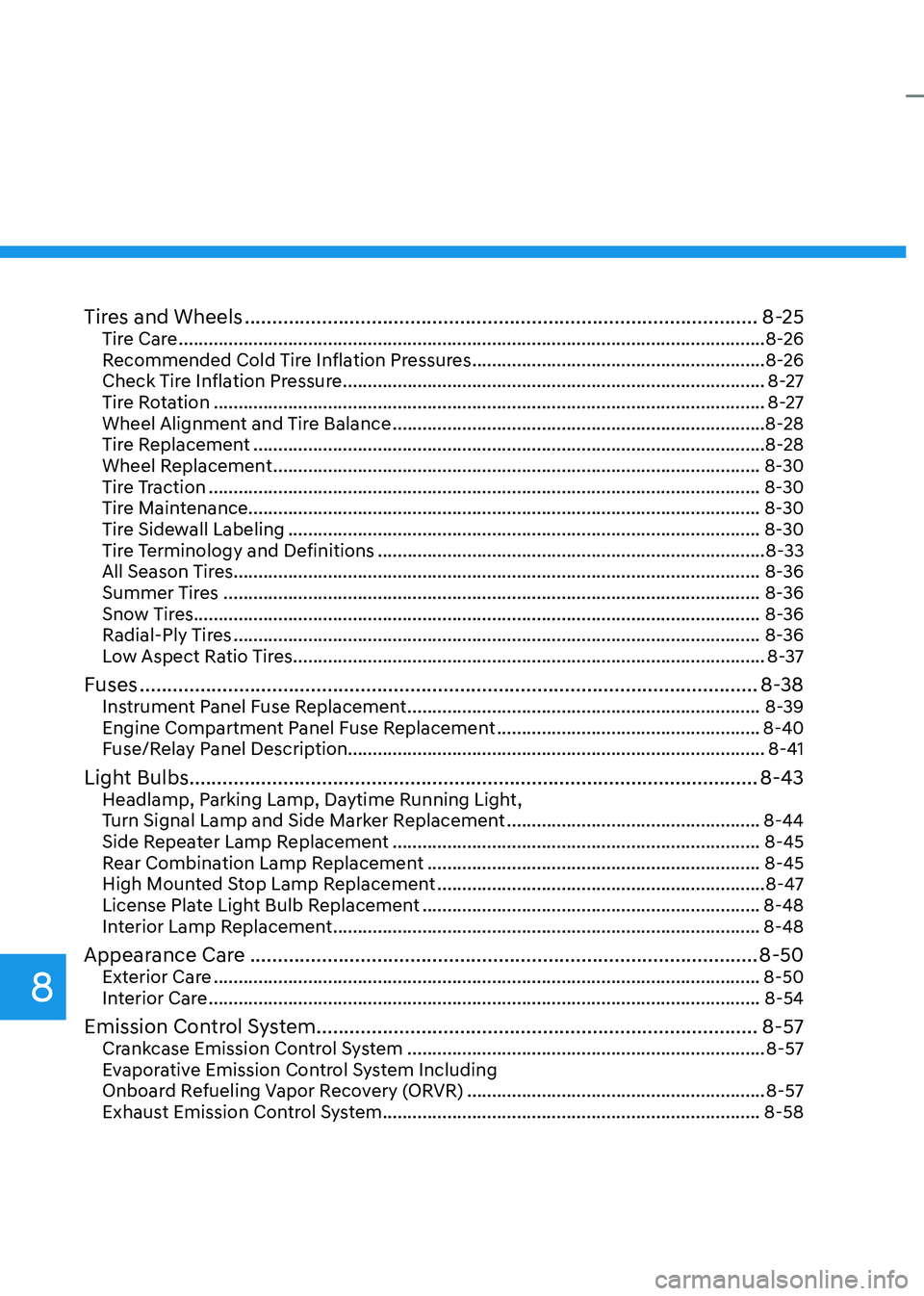
Tires and Wheels ........................................................................\
.....................8-25Tire Care ........................................................................\
..............................................8-26
Recommended Cold Tire Inflation Pressures ...........................................................8-26
Check Tire Inflation Pressure ........................................................................\
.............8-27
Tire Rotation ........................................................................\
.......................................8-27
Wheel Alignment and Tire Balance ........................................................................\
...8-28
Tire Replacement ........................................................................\
...............................8-28
Wheel Replacement ........................................................................\
..........................8-30
Tire Traction ........................................................................\
.......................................8-30
Tire Maintenance ........................................................................\
............................... 8-30
Tire Sidewall Labeling
........................................................................\
.......................8-30
Tire Terminology and Definitions ........................................................................\
......8-33
All Season Tires ........................................................................\
..................................8-36
Summer Tires ........................................................................\
....................................8-36
Snow Tires ........................................................................\
.......................................... 8-36
Radial-Ply Tires
........................................................................\
..................................8-36
Low Aspect Ratio Tires ........................................................................\
.......................8-37
Fuses ........................................................................\
........................................8-38Instrument Panel Fuse Replacement .......................................................................8-39
Engine Compartment Panel Fuse Replacement .....................................................8-40
Fuse/Relay Panel Description ........................................................................\
............ 8-41
Light Bulbs ........................................................................\
...............................8-43Headlamp, Parking Lamp, Daytime Running Light,
Turn Signal Lamp and Side Marker Replacement ...................................................8-44
Side Repeater Lamp Replacement ........................................................................\
..8-45
Rear Combination Lamp Replacement ...................................................................8-45
High Mounted Stop Lamp Replacement ..................................................................8-47
License Plate Light Bulb Replacement ....................................................................8-48
Interior Lamp Replacement ........................................................................\
..............8-48
Appearance Care ........................................................................\
....................8-50Exterior Care ........................................................................\
......................................8-50
Interior Care ........................................................................\
.......................................8-54
Emission Control System ........................................................................\
........8-57Crankcase Emission Control System ........................................................................\
8-57
Evaporative Emission Control System Including
Onboard Refueling Vapor Recovery (ORVR)
............................................................8-57
Exhaust Emission Control System ........................................................................\
....8-58
8
Page 455 of 527
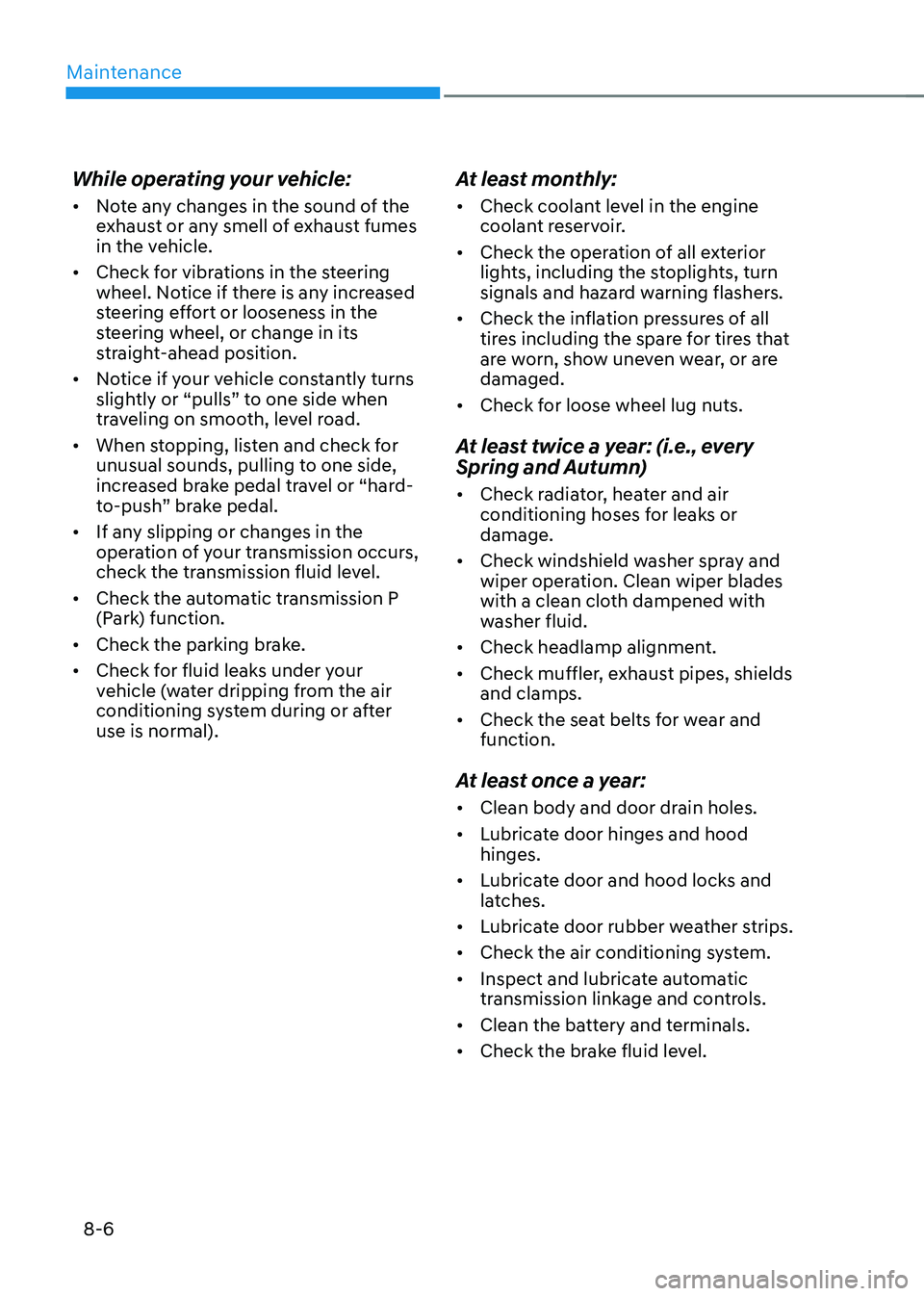
Maintenance
8-6
While operating your vehicle:
• Note any changes in the sound of the
exhaust or any smell of exhaust fumes
in the vehicle.
• Check for vibrations in the steering
wheel. Notice if there is any increased
steering effort or looseness in the
steering wheel, or change in its
straight-ahead position.
• Notice if your vehicle constantly turns
slightly or “pulls” to one side when
traveling on smooth, level road.
• When stopping, listen and check for
unusual sounds, pulling to one side,
increased brake pedal travel or “hard-
to-push” brake pedal.
• If any slipping or changes in the
operation of your transmission occurs,
check the transmission fluid level.
• Check the automatic transmission P
(Park) function.
• Check the parking brake.
• Check for fluid leaks under your
vehicle (water dripping from the air
conditioning system during or after
use is normal).
At least monthly:
• Check coolant level in the engine
coolant reservoir.
• Check the operation of all exterior
lights, including the stoplights, turn
signals and hazard warning flashers.
• Check the inflation pressures of all
tires including the spare for tires that
are worn, show uneven wear, or are
damaged.
• Check for loose wheel lug nuts.
At least twice a year: (i.e., every
Spring and Autumn)
• Check radiator, heater and air
conditioning hoses for leaks or
damage.
• Check windshield washer spray and
wiper operation. Clean wiper blades
with a clean cloth dampened with
washer fluid.
• Check headlamp alignment.
• Check muffler, exhaust pipes, shields
and clamps.
• Check the seat belts for wear and
function.
At least once a year:
• Clean body and door drain holes.
• Lubricate door hinges and hood
hinges.
• Lubricate door and hood locks and
latches.
• Lubricate door rubber weather strips.
• Check the air conditioning system.
• Inspect and lubricate automatic
transmission linkage and controls.
• Clean the battery and terminals.
• Check the brake fluid level.
Page 487 of 527
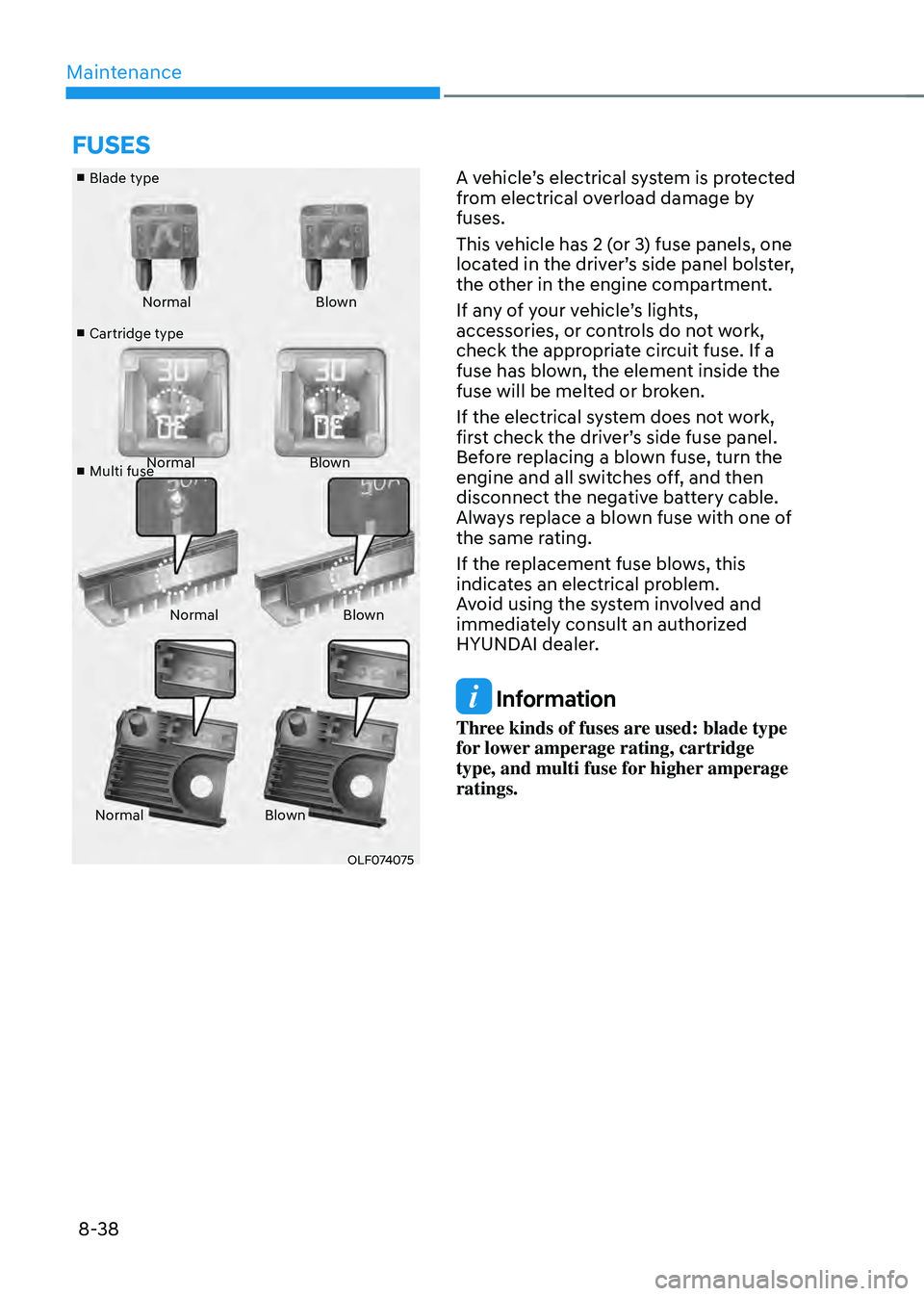
Maintenance
8-38
■ Blade type
■
Cartridge type
■
Multi fuse Normal
Blown
Normal Blown
Normal Blown
Normal Blown
OLF074075
A vehicle’s electrical system is protected
from electrical overload damage by
fuses.
This vehicle has 2 (or 3) fuse panels, one
located in the driver’s side panel bolster,
the other in the engine compartment.
If any of your vehicle’s lights,
accessories, or controls do not work,
check the appropriate circuit fuse. If a
fuse has blown, the element inside the
fuse will be melted or broken.
If the electrical system does not work,
first check the driver’s side fuse panel.
Before replacing a blown fuse, turn the
engine and all switches off, and then
disconnect the negative battery cable.
Always replace a blown fuse with one of
the same rating.
If the replacement fuse blows, this
indicates an electrical problem.
Avoid using the system involved and
immediately consult an authorized
HYUNDAI dealer.
Information
Three kinds of fuses are used: blade type
for lower amperage rating, cartridge
type, and multi fuse for higher amperage
ratings.
FUSES
Page 488 of 527

08
8-39
WARNING
NEVER replace a fuse with anything but
another fuse of the same rating.
• A higher capacity fuse could cause
damage and possibly cause a fire.
• Do not install a wire or aluminum
foil instead of the proper fuse -
even as a temporary repair. It may
cause extensive wiring damage and
possibly a fire.
NOTICE
Do not use a screwdriver or any other
metal object to remove fuses because
it may cause a short circuit and damage
the system.
Instrument Panel Fuse
Replacement
ODN8089015
1. Turn the vehicle off.
2. Turn all other switches off.
3. Open the fuse panel cover.
4. Refer to the label on the inside of
the fuse panel cover to locate the
suspected fuse location.
ODN8H089016
5. Pull the suspected fuse straight out.
Use the removal tool provided in the
engine compartment fuses panel
cover.
6. Check the removed fuse; replace it if
it is blown. Spare fuses are provided in
the instrument panel fuse panels (or in
the engine compartment fuse panel).
7. Push in a new fuse of the same
rating, and make sure it fits tightly in
the clips. If it fits loosely, consult an
authorized HYUNDAI dealer.
In an emergency, if you do not have
a spare fuse, use a fuse of the same
rating from a circuit you may not need
for operating the vehicle, such as the
cigarette lighter fuse.
If the headlamps or other electrical
components do not work and the fuses
are undamaged, check the fuse panel
in the engine compartment. If a fuse is
blown, it must be replaced with the same
rating.
Page 519 of 527

I
I-11
LCD display (Type C) ........................................................................\
................4-39
LCD display control
........................................................................\
...............4-39
View modes
........................................................................\
............................4-40
Utility view mode
........................................................................\
...................4-41
Option menu
........................................................................\
...........................4-43
User settings mode
........................................................................\
.................4-44
LCD display messages
........................................................................\
................4-19
Shift to P to start engine
........................................................................\
..........4-19
Shift to P
........................................................................\
.................................4-19
Low key battery ........................................................................\
....................... 4-19
Press brake pedal to start engine
....................................................................4-19
Key not in vehicle
........................................................................\
..................4-19
Key not detected
........................................................................\
.....................4-19
Press START button again
........................................................................\
.....4-19
12V bettery discharging due to additional electrical devices
..........................4-19
Press START button with key
........................................................................\
4-20
Check BRAKE SWITCH fuse
.......................................................................4-20
Door, Hood, Trunk open indicator
.................................................................4-20
Sunroof open indicator
........................................................................\
...........4-20
Press START button while turning wheel
.......................................................4-20
Check steering wheel lock system
..................................................................4-20
Lights mode
........................................................................\
............................4-21
Wiper mode
........................................................................\
............................4-21
Low pressure
........................................................................\
..........................4-21
Low washer fluid ........................................................................\
..................... 4-21
Low fuel
........................................................................\
..................................4-21
Engine has overheated ........................................................................\
............. 4-21
Check exhaust system
........................................................................\
.............4-22
Check headlight
........................................................................\
.......................4-22
Check turn signal ........................................................................\
..................... 4-22
Check brake light
........................................................................\
....................4-22
Check headlamp LED
........................................................................\
.............4-22
Check Active Air Flap system
........................................................................\
.4-22
Page 520 of 527

Index
I-12
Ready to start driving ........................................................................\
.....1-17, 4-22
Check regenerative brakes
.....................................................................1-17, 4-22
Stop vehicle and check brakes
...............................................................1-17, 4-22
Check Hybrid system
........................................................................\
.....1-17, 4-23
Stop safely and check Hybrid system
....................................................1-18, 4-23
Check Hybrid system. Do not start engine ......................................................4-23
Stop safely and check power supply
......................................................1-18, 4-23
Check virtual engine sound system
........................................................1-18, 4-23
Refuel to prevent Hybrid battery damage
..............................................1-19, 4-23
Refill inverter coolant
........................................................................\
....1-19, 4-23
Park with engine On to charge battery
...................................................1-19, 4-23
Start engine to avoid battery discharge
..................................................1-19, 4-23
LCD display modes
........................................................................\
....................4-25
Trip computer mode
........................................................................\
...............4-26
Turn By Turn (TBT) mode
........................................................................\
.....4-26
Driving assist mode
........................................................................\
................4-26
Master warning mode
........................................................................\
.............4-27
User settings mode
........................................................................\
.................4-27
Light
........................................................................\
............................................5-72
AUTO headlamp position
........................................................................\
......5-72
Daytime running light (DRL) ........................................................................\
.. 5-72
Parking lamp position
........................................................................\
............5-73
Headlamp position
........................................................................\
.................5-73
High beam operation
........................................................................\
..............5-73
High Beam Assist (HBA)
........................................................................\
.......5-74
Turn signals
........................................................................\
............................5-77
Lane change signals
........................................................................\
...............5-77
Battery saver function
........................................................................\
............5-77
Headlamp delay function
........................................................................\
.......5-77
Headlamp leveling device
........................................................................\
......5-78
Light bulbs
........................................................................\
..................................8-43
Lubricants and capacities
........................................................................\
............2-11
Luggage compartment lamp
........................................................................\
.......5-80